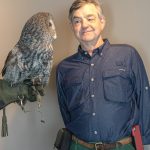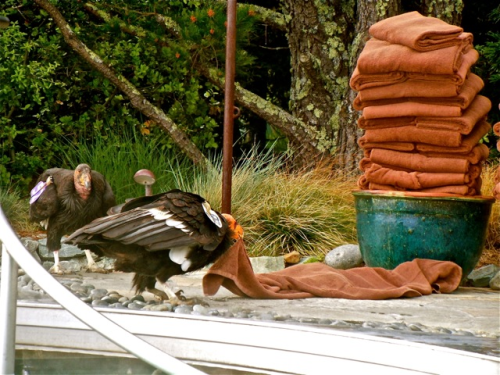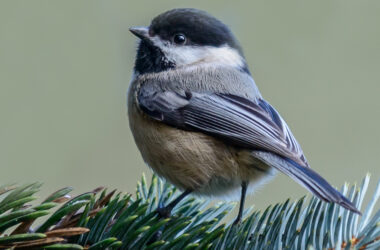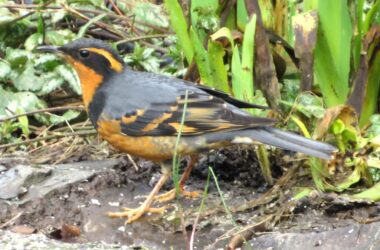California condors are remarkable. Their nine-foot wingspan is the largest of any North American bird. Once nearly extinct, they remain among the rarest native bird species in North America, along with whooping crane and Kirtland’s warbler. Breeding couples produce only one offspring when they nest, and that may not occur every year. Population growth is slow, but their lifespan may extend to sixty years. Condors are highly social: young condors must learn life skills from their elders.
This bird was driven nearly to extinction by people. We took away much of their food
– fewer large sea mammal corpses on shore. People used to shoot condors as trophies. Later, our poisons killed them: DDT, and worst of all, fragments of lead bullets in the animal carcasses they ate. Lead shot is still a problem. Copper bullets would be harmless to scavengers.
The California condor was listed as endangered in 1967, but by 1982 the number of condors in the wild had shrunk to 22. Those were all captured and placed in an intense, carefully managed breeding program. The effort required was immense, as was the expense. And the program is not a matter of years, but of decades. Only in 1992 was the breeding program able to release condors back into the wild, and that continues. Much of that work still depends on a mix of dedicated people and their employers: Peregrine Fund, Ventana Wildlife Society, federal and state agencies here and in Mexico. Zoos in Los Angeles, Oakland and Portland are deeply involved. Of significant importance to the California condor now, certainly, is the program launched by the Yurok tribe.
Before colonization, condors ranged from Baja California to British Columbia. Since earliest times, the condor has been crucial to Yurok culture, and to that of many other tribes along the Pacific Coast. In 2003, the Yurok tribe decided to try to bring condors back to Yurok territory, the lands along the lower Klamath River in Northern California. Years of preparation and work, and negotiation with several partners, led to a program that has worked.
The Yuroks have built a training-and-release facility where young birds meet and learn from older birds that know the training routines and are familiar with the local territory. When the first young condors were released, an adult bird trained them beforehand. The Yuroks regularly feed the free birds so that they willingly return to the release center and can be recaptured for medical exams.
One of the goals of the Yuroks’ program is to get lead out of the territory where the condors scavenge. Their efforts have encouraged many hunters to give up lead shot and use non-toxic shells. Still, one bird had to have its blood cleansed of lead just this year. Condors have been released by the Yuroks three times, so far. All the birds released have been bred in captivity because the death rate in the wild exceeds the birth rate of the free birds. It’s lead poisoning again. Still, there are more than ten wild condors soaring and hunting the Klamath River Basin and surrounding lands. Altogether, there are now about 400 wild condors in the U.S. and Mexico.
While there is no evidence that condors ever nested in Oregon, there were early sightings in all seasons. In November 1805, one of the Lewis and Clark expedition killed a condor near the Columbia River’s mouth. It had a 9.5-foot wingspan.
Those great wings carry the birds far and wide. An adult condor can soar up to 200 miles in a single day. From the Lower Klamath to Brookings is less than 40 miles; to Ashland, less than 140 miles. The last recorded condor sighting in Oregon was in 1904. How long before some lucky person in Oregon records our first sighting of a condor this century?
Read more about Yurok condor program on their website: https://www.yuroktribe.org/yurok-condor-restoration-program.
For information about upcoming Salem Audubon programs and activities, see www.salemaudubon.org, or Salem Audubon’s Facebook page.
Harry Fuller is an Oregon birder and natural history author of “Freeway Birding” and the newly-published “Birding Harney County.” He is a member of the Salem Audubon Society. Contact him at [email protected] or atowhee.blog. His “Some Fascinating Things About Birds” column appears regularly in Salem Reporter.
STORY TIP OR IDEA? Send an email to Salem Reporter’s news team: [email protected].
SUPPORT OUR WORK – We depend on subscribers for resources to report on Salem with care and depth, fairness and accuracy. Subscribe today to get our daily newsletters and more. Click I want to subscribe!

Harry Fuller is an Oregon birder and natural history author of three books: “Freeway Birding,” "Great Gray Owls of California, Oregon and Washington," and "San Francisco's Natural History--Sand Dunes to Streetcars." He leads birding trips for the Malheur Field Station. He is a member of the Salem Audubon Society, and leads bird trips locally. Harry has just published a new book, BIrding Harney County.









